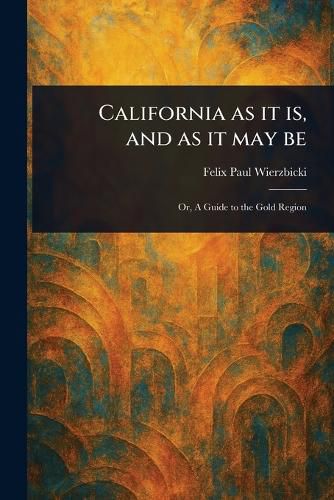Readings Newsletter
Become a Readings Member to make your shopping experience even easier.
Sign in or sign up for free!
You’re not far away from qualifying for FREE standard shipping within Australia
You’ve qualified for FREE standard shipping within Australia
The cart is loading…






This title is printed to order. This book may have been self-published. If so, we cannot guarantee the quality of the content. In the main most books will have gone through the editing process however some may not. We therefore suggest that you be aware of this before ordering this book. If in doubt check either the author or publisher’s details as we are unable to accept any returns unless they are faulty. Please contact us if you have any questions.
"California As It Is and As It May Be: A Guide To The Gold Region" offers a fascinating glimpse into California during the height of the Gold Rush. Written by Feliks Pawel Wierzbicki, this 19th-century travel guide provides a detailed description of the landscape and opportunities awaiting those drawn westward by the promise of fortune.
More than just a guide, this volume captures the spirit of Westward Expansion, offering insights into the social and economic conditions of a state undergoing rapid transformation due to the gold discoveries. Explore California as it was perceived by those who lived through this pivotal period in American history.
A vital historical document for anyone interested in the California Gold Rush, Western history, and the enduring allure of the American West, this meticulously prepared print edition preserves Wierzbicki's observations for readers interested in travel and history.
This work has been selected by scholars as being culturally important, and is part of the knowledge base of civilization as we know it.
This work is in the public domain in the United States of America, and possibly other nations. Within the United States, you may freely copy and distribute this work, as no entity (individual or corporate) has a copyright on the body of the work.
Scholars believe, and we concur, that this work is important enough to be preserved, reproduced, and made generally available to the public. We appreciate your support of the preservation process, and thank you for being an important part of keeping this knowledge alive and relevant.
$9.00 standard shipping within Australia
FREE standard shipping within Australia for orders over $100.00
Express & International shipping calculated at checkout
This title is printed to order. This book may have been self-published. If so, we cannot guarantee the quality of the content. In the main most books will have gone through the editing process however some may not. We therefore suggest that you be aware of this before ordering this book. If in doubt check either the author or publisher’s details as we are unable to accept any returns unless they are faulty. Please contact us if you have any questions.
"California As It Is and As It May Be: A Guide To The Gold Region" offers a fascinating glimpse into California during the height of the Gold Rush. Written by Feliks Pawel Wierzbicki, this 19th-century travel guide provides a detailed description of the landscape and opportunities awaiting those drawn westward by the promise of fortune.
More than just a guide, this volume captures the spirit of Westward Expansion, offering insights into the social and economic conditions of a state undergoing rapid transformation due to the gold discoveries. Explore California as it was perceived by those who lived through this pivotal period in American history.
A vital historical document for anyone interested in the California Gold Rush, Western history, and the enduring allure of the American West, this meticulously prepared print edition preserves Wierzbicki's observations for readers interested in travel and history.
This work has been selected by scholars as being culturally important, and is part of the knowledge base of civilization as we know it.
This work is in the public domain in the United States of America, and possibly other nations. Within the United States, you may freely copy and distribute this work, as no entity (individual or corporate) has a copyright on the body of the work.
Scholars believe, and we concur, that this work is important enough to be preserved, reproduced, and made generally available to the public. We appreciate your support of the preservation process, and thank you for being an important part of keeping this knowledge alive and relevant.